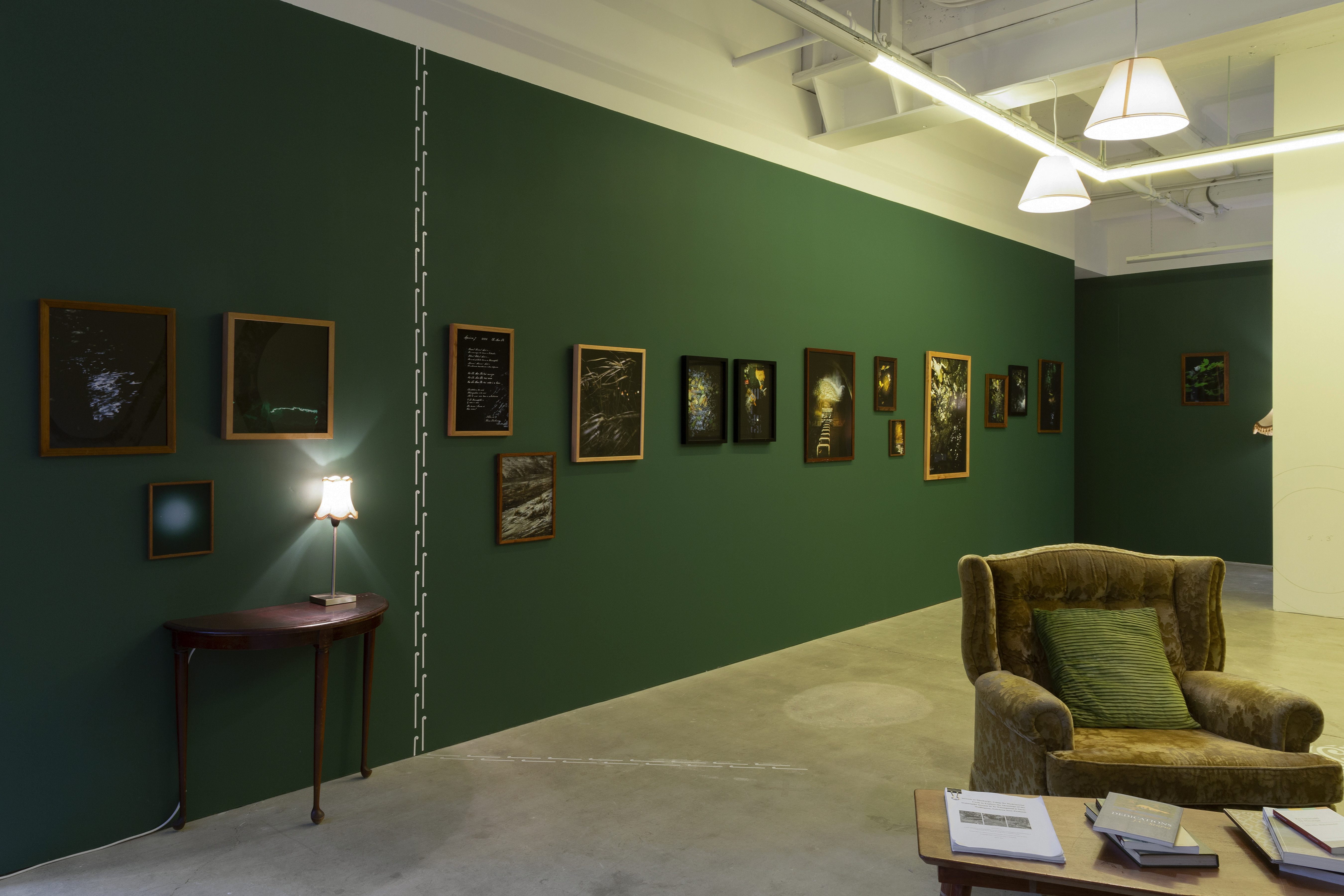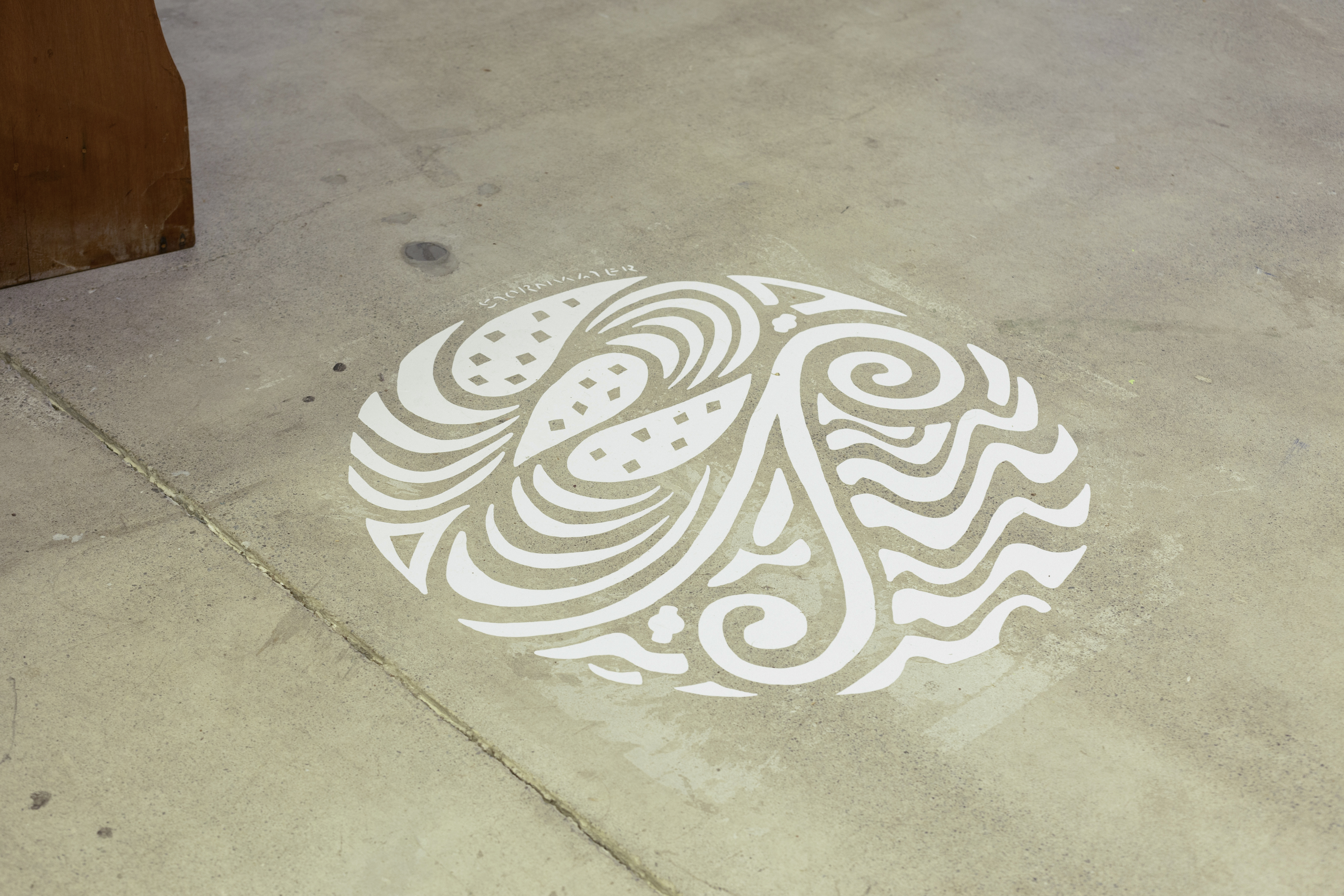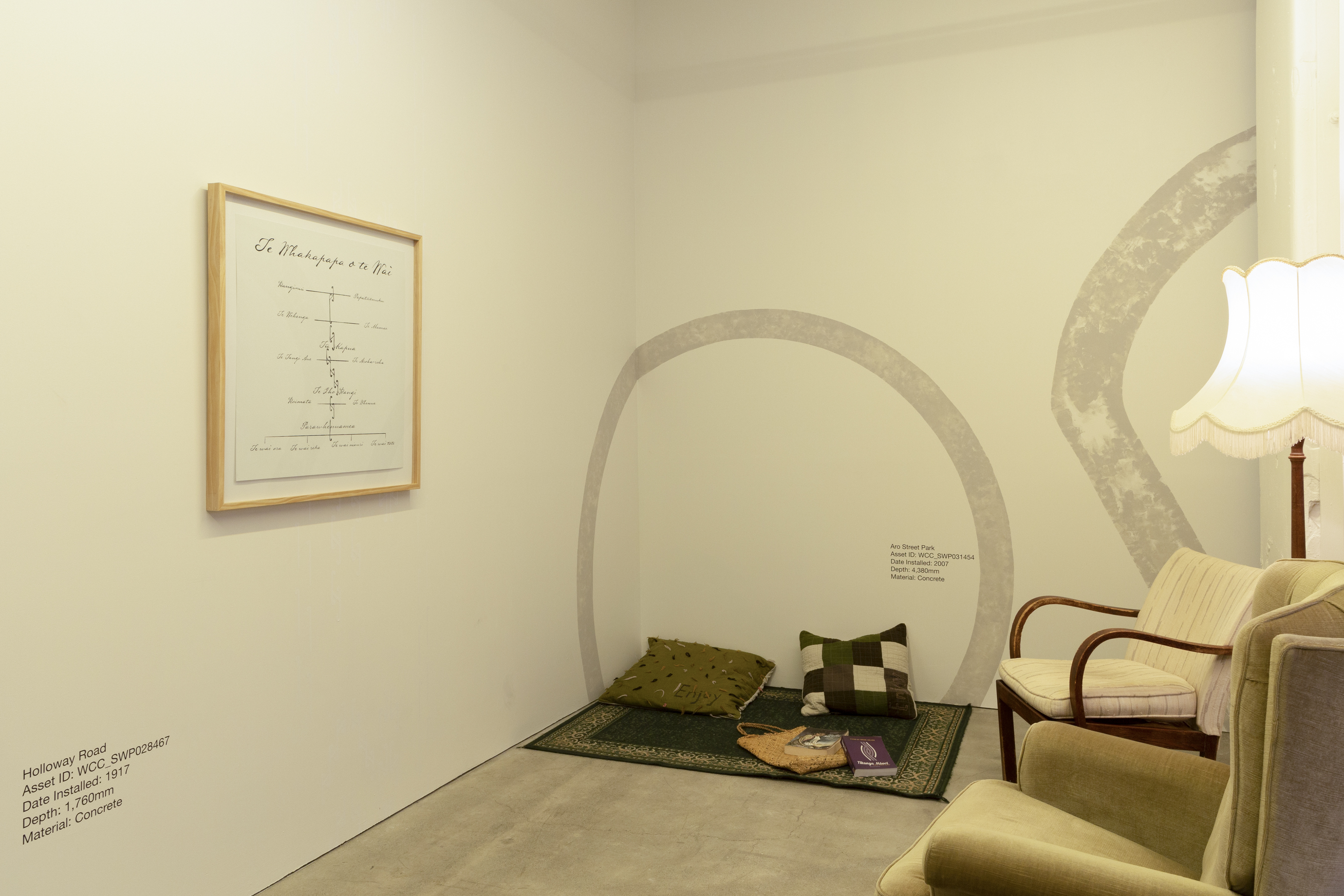
Ko Wai a Māpihi? This is not water
Exhibition by Cae Te Wheoro Heke and Nick Denton
Ko Wai a Māpihi? This is not water | Cae Te Wheoro Heke, Nick Denton | Enjoy, Pōneke
29.05.22 | written by Kasi Valu
A soundscape of water echoes in every chamber of the gallery space. With the recent passing of Moana Jackson I have been reminded of how interconnected water is within the realms of art and academia. It is in the weaving of specific ancestral knowledge, research, and history that informs the universal call for autonomy of Indigenous peoples. This sentiment is expressed in Ko Wai a Māpihi? This is not water by Cae Te Wheoro Heke (Ngā Puhi/Waikato) and Nick Denton (Pākehā, Tangata Tiriti) at Enjoy.
A living room for Māpihi, 2020, establishes a warm embrace, enveloping every member of the public in an immersive experience. Plotted with aged sofas, they beckon each passing body to sit and delve into a variety of resources that centre Indigenous knowledge, shelved into a small oak bookcase. As a space of Te Ao Mārama, a place of understanding, it holds space for conflicting perspectives.
A living room for Māpihi, 2020, establishes a warm embrace, enveloping every member of the public in an immersive experience. Plotted with aged sofas, they beckon each passing body to sit and delve into a variety of resources that centre Indigenous knowledge, shelved into a small oak bookcase. As a space of Te Ao Mārama, a place of understanding, it holds space for conflicting perspectives.

Cae Te Wheoro Heke and Nick Denton, Ko wai a Māpihi? This is not water 2022 (install image). Portraits of Waimapihi, 2022, digital prints, and A living room for Māpihi, 2022, mixed materials.
Along one wall in the gallery are Portraits of Waimāpihi, 2022, Āperira 7 2022 Te Aro Pā, 2022, and details of paintings by John Pearse, Breaking of the soil at Te Aro Flat after a deluge of rain, 1853. The entire wall is painted an enriched forest green, layered atop with meticulously placed digital prints and kupu by Hana Buchanan (Ngāti Haumia, Taranaki and Te Atiawa). Opposite, derived from engineers' blueprints, is Waimapihi Stormwater Pipe Cross-Sections accompanying the three definitions of water sourced directly from the Resource Management Act 1991 (RMA). The RMA deals with the sustainable management of natural and physical resources including water under or above ground but does not extend management to water “in any form while in any pipe, tank, or cistern.”1 By this definition, most of the Waimapihi stream which runs through Pōneke is not even considered water.

Cae Te Wheoro Heke and Nick Denton, Storm water cover design, 2022, vinyl. Reproduction of original design by Tracy Kain, 2006.
Aotearoa is currently on the verge of what could potentially be a complete upheaval of freshwater governance in Aotearoa. At the same time Labour is taking steps to implement the Three Waters Reform for centralised governance of “drinking water, wastewater and stormwater services”,2 Te Rūanga o Ngāi Tahu is taking legal action to establish “rangatiratanga over the wai māori (freshwater) of our takiwā” (region) in order that the Crown and Iwi may “jointly design a better system to manage and care for our precious waterways.”3
It is a reminder of the ongoing impact of a narrow western view that is embedded into our legislation, in this case, property law.4 Such a view can damage the ancestral relationship between tangata whenua and Tangaroa that has existed for lifetimes. The campaign of Ngāi Tahu reflects the bedrock of protest that is ingrained into our waterways, that no law can alter, no matter the definition.
It is a reminder of the ongoing impact of a narrow western view that is embedded into our legislation, in this case, property law.4 Such a view can damage the ancestral relationship between tangata whenua and Tangaroa that has existed for lifetimes. The campaign of Ngāi Tahu reflects the bedrock of protest that is ingrained into our waterways, that no law can alter, no matter the definition.
 Nick Denton and Cae Te Wheoro Heke, Te Arā Waimapihi, 2022. Two channel projected video. Sound composed and performed by Ruby Solly.
Nick Denton and Cae Te Wheoro Heke, Te Arā Waimapihi, 2022. Two channel projected video. Sound composed and performed by Ruby Solly.Heke and Denton do not provide answers, rather present questions for us to consider.
This exhibition provokes imperative kōrero within ourselves and communities. I carried these questions with me.
Following a majestic and serene sound, I find myself in Te Arā o Waimapihi, 2022, a two channel digital video. The sound is composed by Ruby Solly (Kai Tahu, Waitaha, Kāti Māmoe) on cello and taongo pūoro. I am engulfed by the darkness of the room and the simple projected images. This reminds me of the natural power water has when we surrender, listen, and allow it to speak for itself. Listening to the melody of water trickling through crevices of rocks, pipes, and streams, I couldn’t help but think of Moana Jackson’s influence that pervades his lifetime and will continue to live on. His words draw everyone into a space of reflection: “We are not alone in our struggles. We stand in the light of our ancestors.”5 Standing in a dark room, I feel my ancestors communicating my position within the context of this work. As a Tongan child of the Pacific diaspora, living on Indigenous land, the action of solidarity rings in all four chambers of my heart. As Tagata Pasifika, it is our job to stand with Tangata Whenua, especially with matters concerning our most precious and essential resources of life.
“How would we see the city if we knew the tuna was as old as buildings that swim its rivers?”
“How can a city centre indigenous sovereignty?”
This exhibition provokes imperative kōrero within ourselves and communities. I carried these questions with me.
Following a majestic and serene sound, I find myself in Te Arā o Waimapihi, 2022, a two channel digital video. The sound is composed by Ruby Solly (Kai Tahu, Waitaha, Kāti Māmoe) on cello and taongo pūoro. I am engulfed by the darkness of the room and the simple projected images. This reminds me of the natural power water has when we surrender, listen, and allow it to speak for itself. Listening to the melody of water trickling through crevices of rocks, pipes, and streams, I couldn’t help but think of Moana Jackson’s influence that pervades his lifetime and will continue to live on. His words draw everyone into a space of reflection: “We are not alone in our struggles. We stand in the light of our ancestors.”5 Standing in a dark room, I feel my ancestors communicating my position within the context of this work. As a Tongan child of the Pacific diaspora, living on Indigenous land, the action of solidarity rings in all four chambers of my heart. As Tagata Pasifika, it is our job to stand with Tangata Whenua, especially with matters concerning our most precious and essential resources of life.
 Cae Te Wheoro Heke and Nick Denton, Te Whakapapa o te Wai, 2022, digital print. Waimapihi Stormwater Pipe Cross-Sections, 2022, wall painting and vinyl (detail).
Cae Te Wheoro Heke and Nick Denton, Te Whakapapa o te Wai, 2022, digital print. Waimapihi Stormwater Pipe Cross-Sections, 2022, wall painting and vinyl (detail).I saw and felt values of Te Ao Māori seamlessly emulated and embedded in every space of Ko wai a Māpihi? This is not water. This exhibition extends manaakitanga to every visitor. Within the intersection of academia and art, matauranga is offered through pre and post colonial resources that underpin the necessary knowledge to understand the indescribable depth of a connection with water. Whanaungatanga—it is the water that connects us all. Water is life; it nurtures, holds, feeds, and carries us. It is the water, rivers, oceans that connect us. It is the water within this exhibition that has gathered a community of people to recognise the complex history, and politics of the very land they stand upon in order to navigate the coming future.
Ko wai a Māpihi? This is not water is an exhibition by Cae Te Wheoro Heke and Nick Denton at Enjoy Contemporary Art Space 14 April – 25 May. Including works by taonga pūoro artist Ruby Solly (Kai Tahu, Waitaha, Kāti Māmoe), and toi kupu / writing by Hana Buchanan (Ngāti Haumia, Taranaki and Te Atiawa).
All images courtesy of the artists and Enjoy. Photo credit Cheska Brown.

Article image: A living room for Māpihi, 2022, mixed materials and Waimapihi Stormwater Pipe Cross-Sections, 2022, wall painting and vinyl.
1. Resource Management Act 1991, Part 1 , Secton 2: Interpretation.
2. Three Waters Reform boiled down — a quick overview, provided by The Department of Internal Affairs, 2022.
https://www.dia.govt.nz/diawebsite.nsf/Files/Three-waters-reform-programme-2022/$file/Three-Waters-Reform-boiled-down-1.pdf (viewed 20.05.22)
3. Enough is enough: Why Ngāi Tahu is suing the Crown over its waterways, Lisa Tumahai, first published 4 November 2020 on The Spinoff.
https://thespinoff.co.nz/atea/04-11-2020/enough-is-enough-why-ngai-tahu-is-suing-the-crown-over-its-waterways (viewed 19.05.22)
4. The RMA 1991 restricts the comprehensive protection of water due to being derived largely from a 19th century concept of property rights which, in turn, is based on a 17th century concept.
See: Water rights for Ngāi Tahu: A discussion paper, Te Maire Tau, 2017. Canterbury University Press, Christchurch. pp. 55–56.
5. Quote attributed to Moana Jackson.
Ko wai a Māpihi? This is not water is an exhibition by Cae Te Wheoro Heke and Nick Denton at Enjoy Contemporary Art Space 14 April – 25 May. Including works by taonga pūoro artist Ruby Solly (Kai Tahu, Waitaha, Kāti Māmoe), and toi kupu / writing by Hana Buchanan (Ngāti Haumia, Taranaki and Te Atiawa).
All images courtesy of the artists and Enjoy. Photo credit Cheska Brown.
Article image: A living room for Māpihi, 2022, mixed materials and Waimapihi Stormwater Pipe Cross-Sections, 2022, wall painting and vinyl.
1. Resource Management Act 1991, Part 1 , Secton 2: Interpretation.
2. Three Waters Reform boiled down — a quick overview, provided by The Department of Internal Affairs, 2022.
https://www.dia.govt.nz/diawebsite.nsf/Files/Three-waters-reform-programme-2022/$file/Three-Waters-Reform-boiled-down-1.pdf (viewed 20.05.22)
3. Enough is enough: Why Ngāi Tahu is suing the Crown over its waterways, Lisa Tumahai, first published 4 November 2020 on The Spinoff.
https://thespinoff.co.nz/atea/04-11-2020/enough-is-enough-why-ngai-tahu-is-suing-the-crown-over-its-waterways (viewed 19.05.22)
4. The RMA 1991 restricts the comprehensive protection of water due to being derived largely from a 19th century concept of property rights which, in turn, is based on a 17th century concept.
See: Water rights for Ngāi Tahu: A discussion paper, Te Maire Tau, 2017. Canterbury University Press, Christchurch. pp. 55–56.
5. Quote attributed to Moana Jackson.
ISSN 2744-7952
Thank you for reading ︎
Vernacular logo designed by Yujin Shin
vernacular.criticism ︎

